

Spazzacamini (Italian for chimney sweep) was the term for child laborers in 19th- and early 20th-century Italy and Switzerland, where they were also known as Kaminfegerkinder in German-speaking areas. [1]


Spazzacamini (Italian for chimney sweep) was the term for child laborers in 19th- and early 20th-century Italy and Switzerland, where they were also known as Kaminfegerkinder in German-speaking areas. [1]
Most of the boys, usually 8 to 12 years old, were from the canton of Ticino, coveted by their padroni chimney sweepers because they were small and slim and therefore able to climb the narrow chimneys and to clean them. When the boys had reached the top of the chimneys, they had to shout "Spazzacamini!" to prove that they actually had climbed up the dark, stuffy fireplaces. The working conditions were catastrophic. For lunch, the children often had nothing to eat and had to go begging for bread, and they had often to sleep in stables. The boys were hired in the winter, so at the family tables in the badly developed valleys of Ticino one mouth less had to be fed. At that time, bitter poverty and hunger was widely spread in Ticino during the winter months. Many children came from the Valle Verzasca, the Cento Valli and also from the Italian Val Vigezzo valleys, [2] and frequently worked in northern Italy.
Every autumn in Vigezzo chimney sweeps from all over the world meet in memory of the chimney sweep child slaves. [2] The children's book Die schwarzen Brüder ("The Black Brothers") was first published in two volumes in 1940–41. The story of Giorgio, a little boy from Sonogno in the Verzasca Valley who had been used as Kaminfegerjunge, is based on facts. Lisa Tetzner had read in ancient chronicles about the fate of such small boys from the Verzasca Valley and other valleys of the Ticino. The book is popular and, amongst others, a film, a television serial, a musical and a radio play have been based on the novel, as well as naming a hiking route starting in Sonogno in the Verzasca Valley. [3]
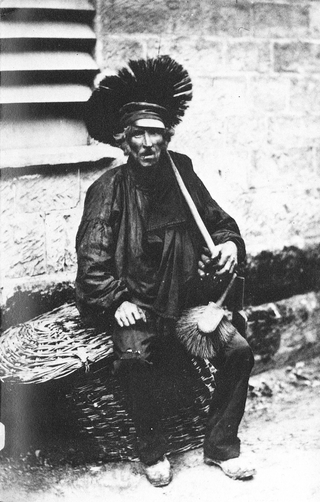
A chimney sweep is a person who inspects then clears soot and creosote from chimneys. The chimney uses the pressure difference caused by a hot column of gas to create a draught and draw air over the hot coals or wood enabling continued combustion. Chimneys may be straight or contain many changes of direction. During normal operation, a layer of creosote builds up on the inside of the chimney, restricting the flow. The creosote can also catch fire, setting the chimney alight. The chimney must be swept to remove the soot.

Cugnasco is a village in the municipality Cugnasco-Gerra of the district of Locarno in the canton of Ticino in Switzerland.
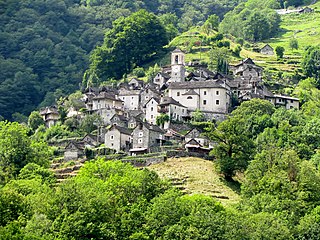
Corippo is a village and former municipality in the district of Locarno in the canton of Ticino in Switzerland.

Frasco is a village and former municipality in the district of Locarno in the canton of Ticino in Switzerland. On 17 October 2020 the former municipalities of Vogorno, Sonogno, Corippo, Brione (Verzasca) and Frasco merged to form the new municipality of Verzasca.

Intragna is a village and locality in the municipality of Centovalli in the district of Locarno of the canton of Ticino in Switzerland.
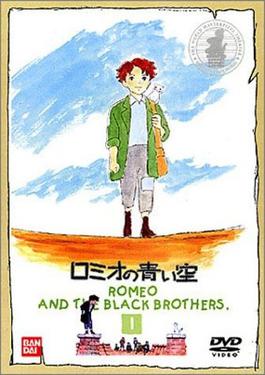
Romeo and the Black Brothers is a 1995 Japanese anime series by Nippon Animation. Although "Romeo's Blue Skies" is the literal translation of the Japanese title, the official English name given by Nippon Animation is "Romeo and the Black Brothers".

Vogorno is a village and former municipality in the district of Locarno in the canton of Ticino in Switzerland. The village is located above Lago di Vogorno, a reservoir formed by the Verzasca Dam. On 17 October 2020 the former municipalities of Vogorno, Sonogno, Corippo, Brione (Verzasca) and Frasco merged to form the new municipality of Verzasca.
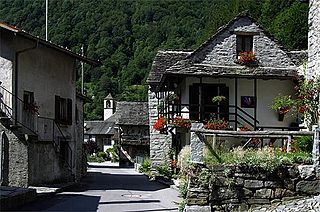
Brione (Verzasca) is a village and former municipality in the district of Locarno in the canton of Ticino in Switzerland. On 17 October 2020 the former municipalities of Vogorno, Sonogno, Corippo, Brione (Verzasca) and Frasco merged to form the new municipality of Verzasca.
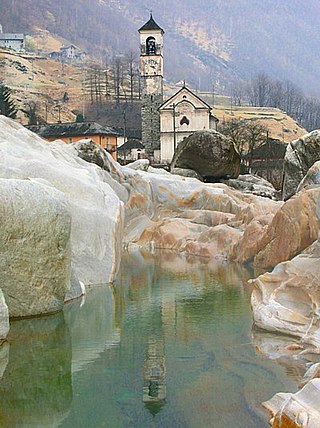
Lavertezzo is a municipality in the district of Locarno in the canton of Ticino in Switzerland.
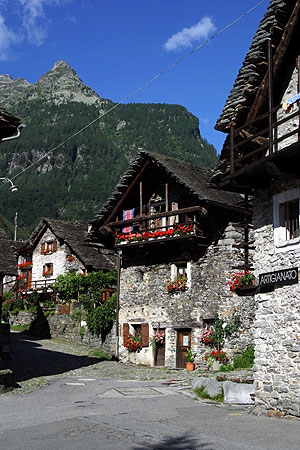
Sonogno is a village and former municipality in the district of Locarno in the canton of Ticino in Switzerland. It is located in Valle Verzasca. On 17 October 2020 the former municipalities of Vogorno, Sonogno, Corippo, Brione (Verzasca) and Frasco merged to form the new municipality of Verzasca.

The Valle Verzasca is a valley in the Locarno district of the canton of Ticino, Switzerland. It comprises the municipalities of Mergoscia, Vogorno, Corippo, Lavertezzo, Brione, Gerra, Frasco, and Sonogno. As of 2004, the total population is 3,200. It is the most central valley of Ticino, and none of the passes out of the valley cross cantonal or national borders. The valley is formed by the river Verzasca and is situated between the Leventina and the Maggia and culminates at Pizzo Barone.

Someo is a village and former municipality in the district of Vallemaggia in the canton of Ticino, Switzerland.

Lisa Tetzner was a German-born Swiss children's book writer known for her work with fairy-tales. In 1924 she married Kurt Held, a Jewish Communist. They fled to Switzerland in 1933 to escape the Nazis and in 1948 became Swiss citizens. Her book, Die schwarzen Brüder was published in 1941. The Swiss censored her work fearing it may antagonise the wartime German government. Later her "socialist fairy-tales" became popular in East Germany. One of her best-known works is The Children From No. 67 series written as a collaboration with her husband. In the US Hans Sees The World was popular. It was a translation from her original German, published in 1934 by Covici-Friede.
Landscape mythology and anthropology of landscape are terms for a field of study advocated since about 1990 by Kurt Derungs. Derungs describes the field as an interdisciplinary approach to landscape combining archaeology, ethnology and mythology.

Cugnasco-Gerra is a municipality in the canton of Ticino, Switzerland. It was formed on January 1, 2009, through the merger of Cugnasco and Gerra.
Friedrich Siegfried Heinrich Ludwig von Gerdtell was a German theologian associated with the Disciples of Christ movement.
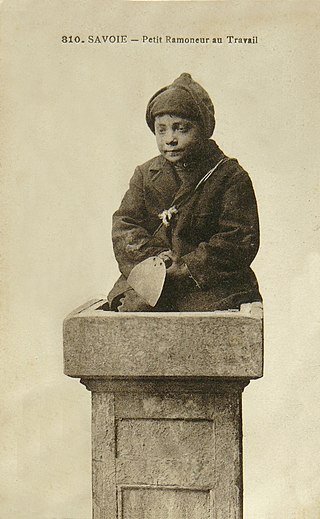
Die schwarzen Brüder is the best-known story of German-Swiss writers Lisa Tetzner and Kurt Held.

The Grünenberg family was a medieval Swiss noble family. The family was active from the middle of the 12th century until the 15th century in the Swiss Plateau, mostly in the Bernese Oberaargau. There were two major branches, the Grimme and Schnabel lines which then further divided into other branches. Some of these branches owned land in Alsace and in southern Bavaria, especially in the Markgräflerland and in Breisgau. About one hundred members of the family are known today. The family name comes from Grünenberg Castle in Melchnau in the Canton of Bern.

Verzasca is a municipality in the district of Locarno in the canton of Ticino in Switzerland.

Bagni di Craveggia is a frazione of the municipality of Craveggia, in Piedmont, northern Italy. It is located in the Onsernone Valley at 986 m (3,235 ft), on the border of Switzerland. Road access is through Spruga, a village in the municipality of Onsernone, which lies across the Isorno river. It owes its name to a source of thermal water at 28 °C (82 °F).
{{cite magazine}}: Cite magazine requires |magazine= (help)